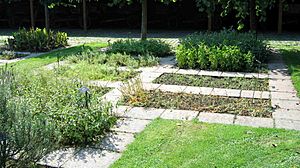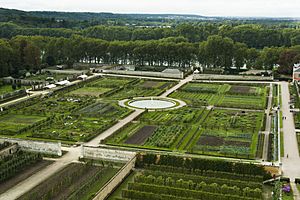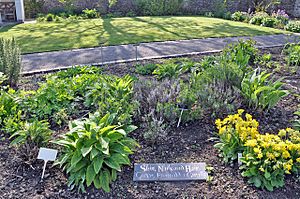Kitchen garden facts for kids
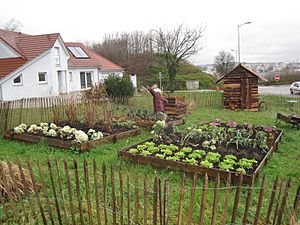
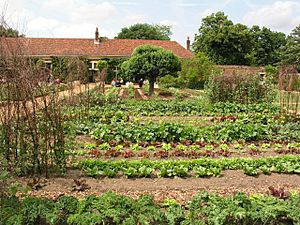
A kitchen garden is a special part of a garden. It's also called a vegetable garden or a potager (from French). In Scotland, it's known as a kailyaird. This area is separate from the pretty flower beds and grassy lawns. It's used to grow plants you can eat, like vegetables, fruits, and herbs. Sometimes, people also grew medicinal plants here in the past.
These plants are grown mainly for the family living in the house. If there's extra food, it might be given away or sold. But a place that grows many different vegetables to sell is usually called a market garden. A kitchen garden is different from an allotment. An allotment is a small piece of land rented by someone to grow food. A kitchen garden is on private land, usually very close to the house. It was important for the cook to reach it quickly.
In the past, most small country gardens were kitchen gardens. But in big country houses, the kitchen garden was a separate area. It was often a rectangle and surrounded by a wall or hedge. Walls were good for growing fruit trees against them. They also protected plants from the wind. Large kitchen gardens often had greenhouses. They even had heated hothouses for delicate plants. Sometimes, flowers for the house were grown there too. An orangery was a special type of heated greenhouse for citrus trees.
For large houses, the kitchen garden was usually behind and to the side of the house. This way, it didn't block the views from the front. It was still easy to get to. Big country houses rarely bought vegetables, herbs, or fruit. Any extra food was often given as gifts. For example, the walled kitchen garden at Croome Court in England is huge, covering seven acres!
In early America, kitchen gardens were very important for families. They showed that people could grow their own food. During World War II, it was hard to get enough food. So, many people in Europe, especially Britain, started growing vegetables in small gardens. The government encouraged this a lot. Today, many people like to mix food plants with pretty flowers in their gardens. Fruit trees and cooking herbs are popular choices for this.
Contents
Seeing the Kitchen Garden
In big country house gardens, walls also helped hide the kitchen garden. It was seen as a place for "hard work." This was different from the more beautiful parts of the garden. Gardeners often had to stay out of the main garden when the family or guests were walking there. The kitchen garden gave them a place to work at these times.
Most visitors were not expected to go into the kitchen garden without permission. But some owners, like King Louis XIV, liked to show their guests the kitchen garden. This was especially true if the guests were interested in gardening. At the gardens of Versailles, the huge potager (kitchen garden) was not connected to the main gardens. Its wall was so thick that visitors could walk along the top with the king. This gave them a better view, like walking on castle battlements.
History of Kitchen Gardens
A French doctor and printer named Charles Estienne wrote a lot about 16th-century kitchen gardens. His book, Maison Rustique, shared many ideas from older writers. He said that this practical garden should be separate from the pleasure gardens. It should be surrounded by a thick hedge or wall. Estienne thought hedges were stronger and cheaper to fix. But later, walls became more common. Some walls were even heated from inside by furnaces! Walls also leave more clues for people who study old gardens.
Estienne suggested planting hedges with gooseberry bushes, medlar trees, and olive trees. He also mentioned woodbine, whitethorn, wild apples, brambles, and eglantines. Gardeners would weave fences from willow branches. These were replaced every year. Sometimes, they used juniper poles made stronger with charred oak.
In the Middle Ages, the kitchen garden was often a separate area. It was sometimes far from the main house. For example, the Covent Garden area of London got its name because it was the kitchen garden for Westminster Abbey. This was even though it was some distance from the abbey. By the mid-17th century, many kitchen gardens were moved even further away. They had a service road leading to the main house. At Versailles, you even have to cross a public road to reach the kitchen garden.
In the UK, by the 1800s, many new types of vegetables were being grown. There were lots of magazines, clubs, and competitions at local fairs. Growing vegetables became a very popular hobby. Some gardeners focused on growing huge vegetables, like giant leeks. New allotments were created. These were small plots of land given by local councils or charities. Often, only edible plants could be grown there.
Plants in a Kitchen Garden

According to Charles Estienne, turnips needed the most space. Next to them, people planted coleworts. A path led to plots of sorrel, arugula, parsley, spinach, beets, and orach. Another path separated these greens from root vegetables. These included leeks, onions, garlic, carrots, and scallions.
People also grew edible flowers and winter herbs. These included thyme, sage, lavender, rosemary, hyssop, southern wormwood, savoury, lemon balm, basil, costmary, spikenard, chamomile, and pennyroyal.
Marigolds could grow year after year in fields. People believed their juice and flowers had many benefits. They thought it could soothe eye irritation or ease tooth pain. Strawberry juice and wine were also thought to help the eyes. Estienne said that strawberries "had no neede of greate toile or tilling" (didn't need much work). Today, scientists still study if less digging helps strawberry plants grow better.
Other plants found in kitchen gardens included: asparagus, artichoke, sow thistle, endive, chicory, watercress, chives, parsnips, purslane, smallage, tarragon, borage, bugloss, radishes, rapeseed, skirret, poppy, mustard, cucumbers and gourds. If the soil and weather were right, Citrus fruits and melons could also be part of the kitchen garden.
Modern Potager Gardens
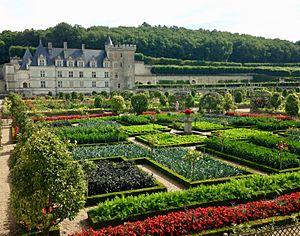
In some modern gardens, edible plants and herbs are planted alongside ornamental plants. Fruit trees are a common way to do this. The goal is to make growing food look beautiful.
Plants are chosen for their use, but also for their color and shape. Many are trained to grow upwards. A well-designed potager can provide food, cut flowers, and herbs for the home. It often needs very little care. Potagers can look very different. They can be like a cozy cottage garden or a formal knot garden.
The owner of the Château de Villandry in France decided to create a French formal garden. It has a fancy design of beds surrounded by low hedges. But instead of flowers, they planted kitchen garden plants! This amazing garden has become a popular tourist spot. However, it's not how these gardens looked historically.
Vegetable Garden
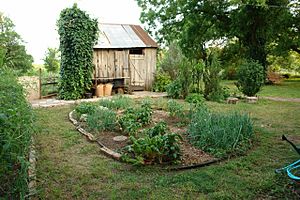
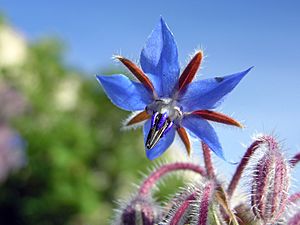
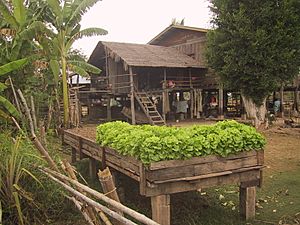
A vegetable garden is a garden where you grow vegetables and other plants for people to eat. This is different from a flower garden, which is grown just for beauty. It's a small way of growing vegetables. A vegetable garden usually has a compost heap. It also has several plots or areas of land. Each plot might grow one or two types of plants. Plots can also be divided into rows with different vegetables. It's usually located at the back of a house.
About one-third of adults in the UK and America grow food in their own or community gardens. During World War II, many people had a "victory garden". These gardens provided food and helped save resources for the war effort.
Today, with more interest in healthy living, many people are starting vegetable gardens. Growing food in your backyard uses little fuel for shipping. You also know exactly what was used to grow your food. Organic horticulture, or organic gardening, is very popular for home gardeners now.
Herb Garden
An herb garden is often a separate part of the garden. It's used for growing a special group of plants called herbs. These gardens can be simple patches of plants. Or they can be carefully designed, with plants clipped into patterns, like a knot garden.
Herb gardens can be just for practical use, or they can mix useful and pretty plants. Herbs are usually used to flavor food when cooking. But they can also be used in other ways. For example, some herbs can keep pests away. Others provide nice smells or are used for medicine, like in a physic garden.
You can create a kitchen garden by planting different herbs in pots or containers. This lets you move them around. Not all herbs grow well in pots, but some do better than others. Mint, for example, smells great but spreads very quickly. It's a good idea to keep mint in a container so it doesn't take over your whole garden!
Some Walled Kitchen Gardens You Can Visit
These gardens are open to the public.
- Croome Court
- Gibside, NT (National Trust), some parts are now used as volunteer allotments.
- Ham House, NT, mostly used for vegetables.
- Clumber Park
See also
 In Spanish: Huerto para niños
In Spanish: Huerto para niños


